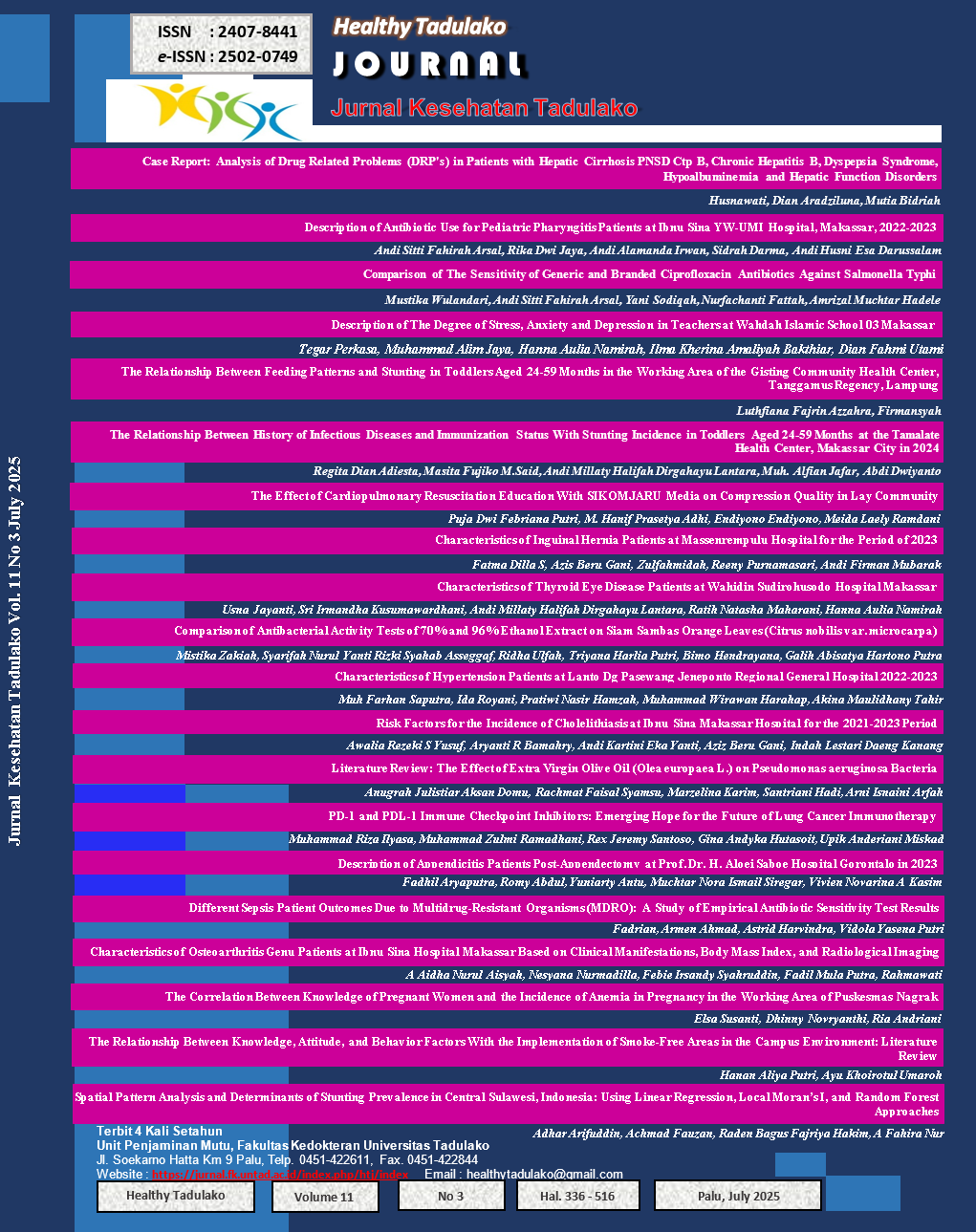Spatial Pattern Analysis and Determinants of Stunting Prevalence in Central Sulawesi, Indonesia: Using Linear Regression, Local Moran’s I, and Random Forest Approaches
DOI:
https://doi.org/10.22487/htj.v11i3.1863Abstract
Background: Stunting remains a significant public health issue in Indonesia, particularly in Central Sulawesi, where socio-economic and environmental factors contribute to its prevalence. Understanding these determinants is crucial for effective intervention strategies. Objective: This study aims to analyze the spatial distribution and predictors of stunting prevalence in Central Sulawesi, focusing on socio-economic and environmental factors. Methods: An observational design was employed, utilizing secondary data from the Central Sulawesi Provincial Health Department. Spatial analysis, including Moran’s I and Local Moran’s I, assessed spatial autocorrelation and identified outliers. Regression analysis and Random Forest modeling examined predictors of stunting prevalence. Results: The study found significant spatial clustering in stunting prevalence. Key socio-economic factors identified were maternal education and household income, with poverty being the most influential predictor. Random Forest analysis highlighted sanitation and access to health facilities as important, although access to clean water did not show a significant effect. Conclusion: The findings provide valuable insights into the socio-economic determinants of stunting and emphasize the need for targeted, comprehensive intervention strategies focusing on improving maternal education and addressing poverty, along with enhancing healthcare access in Central Sulawesi
References
Prendergast AJ, Humphrey JH. The stunting syndrome in developing countries. Paediatr Int Child Health. 2014;34(4):250-265. doi:10.1179/2046905514Y.0000000158
Tamir TT, Gezhegn SA, Dagnew DT, Mekonenne AT, Aweke GT, Lakew AM. Prevalence of childhood stunting and determinants in low and lower-middle income African countries: Evidence from standard demographic and health survey. Kundu S, ed. PLOS ONE. 2024;19(4):e0302212. doi:10.1371/journal.pone.0302212
Anastasia H, Hadju V, Hartono R, et al. Determinants of stunting in children under five years old in South Sulawesi and West Sulawesi Province: 2013 and 2018 Indonesian Basic Health Survey. Cardoso MA, ed. PLOS ONE. 2023;18(5):e0281962. doi:10.1371/journal.pone.0281962
Arifuddin A, Zuchdi D, Rosana D, et al. Strengthening of early children’s character education stunting children in Indonesia. J Educ Health Promot. 2023;12(1). doi:10.4103/jehp.jehp_1857_22
Nur AF, Suriati, Nur MJ, et al. The village government’s communication model: A promotion strategy for stunting prevention in Indonesia. Public Health Indones. 2023;9(4):186-196. doi:10.36685/phi.v9i4.719
Astuti SJW, Suindyah Dwiningwarni S, Atmojo S. Modeling environmental interactions and collaborative interventions for childhood stunting: A case from Indonesia. Dialogues Health. 2025;6:100206. doi:10.1016/j.dialog.2025.100206
Siramaneerat I, Astutik E, Agushybana F, Bhumkittipich P, Lamprom W. Examining determinants of stunting in Urban and Rural Indonesian: a multilevel analysis using the population-based Indonesian family life survey (IFLS). BMC Public Health. 2024;24(1):1371. doi:10.1186/s12889-024-18824-z
Kustanto A, Rachmat O, Setyadi S. The Prevalence of Stunting in Indonesia: An Examination of the Health, Socioeconomic Status, and Environmental Determinants. J Iran Med Counc. Published online November 24, 2024. doi:10.18502/jimc.v8i1.17062
Ejike CE, Uwadoka N, Igwe-Ogbonna N. Things seen and unseen: 1. Stunting and overweight/obesity are predominant malnutrition burdens of urban poor Nigerian adolescents. Ann Glob Health. 2024;90(1):64. doi:10.5334/aogh.4550
Kirby RS, Delmelle E, Eberth JM. Advances in spatial epidemiology and geographic information systems. Ann Epidemiol. 2017;27(1):1-9. doi:10.1016/j.annepidem.2016.12.001
Asparian A, Wisudariani E, Syukri M, Putri CI. Spatial Autocorrelation Analysis to Identify Hotspots of Stunting Cases in Kerinci Regency. J Bidan Cerdas. 2024;6(1):1-10. doi:10.33860/jbc.v6i1.3480
Chandran A, Roy P. Applications of geographical information system and spatial analysis in Indian health research: a systematic review. BMC Health Serv Res. 2024;24(1):1448. doi:10.1186/s12913-024-11837-9
Tahangnacca M, Muntahaya F. Spatial Pattern of Stunting on Children under Five in Indonesia 2019. J Kesehat REPRODUKSI. 2023;13(1):47-55. doi:10.58185/jkr.v13i1.36
Pertiwi TS, Nurmalasari M, Qomarania WZ, Supryatno A, Saputra AI, Salim A. Autocorrelation Spatial Based on Specific Nutritional Interventions Achievement with Stunting Cases in Toddlers at Kendari City Using Local Indicator of Spatial Autocorrelation (LISA) Method. Public Health Indones. 2024;10(3):391-406. doi:10.36685/phi.v10i3.834
Kuse KA, Debeko DD. Spatial distribution and determinants of stunting, wasting and underweight in children under-five in Ethiopia. BMC Public Health. 2023;23(1):641. doi:10.1186/s12889-023-15488-z
Hasdyna N, Dinata RK, Rahmi, Fajri TI. Hybrid Machine Learning for Stunting Prevalence: A Novel Comprehensive Approach to Its Classification, Prediction, and Clustering Optimization in Aceh, Indonesia. Informatics. 2024;11(4):89. doi:10.3390/informatics11040089
Mason L, Hicks B, Almeida J. Demystifying Spatial Dependence: Interactive Visualizations for Interpreting Local Spatial Autocorrelation. arXiv. Preprint posted online August 5, 2024. doi:10.48550/arXiv.2408.02418
Ayalew MM, Dessie ZG, Mitiku AA, Zewotir T. Exploring the spatial and spatiotemporal patterns of severe food insecurity across Africa (2015–2021). Sci Rep. 2024;14(1):29846. doi:10.1038/s41598-024-78616-8
Rahut DB, Mishra R, Bera S. Geospatial and environmental determinants of stunting, wasting, and underweight: Empirical evidence from rural South and Southeast Asia. Nutrition. 2024;120:112346. doi:10.1016/j.nut.2023.112346
Beal T, Tumilowicz A, Sutrisna A, Izwardy D, Neufeld LM. A review of child stunting determinants in INDONESIA. Matern Child Nutr. 2018;14(4):e12617. doi:10.1111/mcn.12617
Wicaksono F, Harsanti T. Determinants of Stunted Children in Indonesia: A Multilevel Analysis at the Individual, Household, and Community Levels. Kesmas Natl Public Health J. 2020;15(1):48. doi:10.21109/kesmas.v15i1.2771
Masit J, Malenje B, Imboga H. Spatial Patterns and Risk Factors of Stunting Among Under-five Children in Kenya: A Multilevel and Spatial Analysis. Int J Data Sci Anal. 2024;10(3):49-60. doi:10.11648/j.ijdsa.20241003.12
Usman M, Kopczewska K. Spatial and Machine Learning Approach to Model Childhood Stunting in Pakistan: Role of Socio-Economic and Environmental Factors. Int J Environ Res Public Health. 2022;19(17):10967. doi:10.3390/ijerph191710967
Roy TB, Das T, Das P, Das P. Analyzing determinants from both compositional and contextual level impeding desired linear growth of children in Indian context. BMC Nutr. 2023;9(1):69. doi:10.1186/s40795-023-00725-w
Ijonu UNS, Jaya IGNM, Arisanti R. Spatially Varying Regression Coefficient Model For Predicting Stunting Hotspots In Indonesia. J Penelit Pendidik IPA. 2024;10(10):7748-7755. doi:10.29303/jppipa.v10i10.8270
Salman HA, Kalakech A, Steiti A. Random Forest Algorithm Overview. Babylon J Mach Learn. 2024;2024:69-79. doi:10.58496/BJML/2024/007
He L, Levine RA, Fan J, Beemer J, Stronach J. Random Forest as a Predictive Analytics Alternative to Regression in Institutional Research. Pract Assess Res Eval. 2018;23(1). http://pareonline.net/getvn.asp?v=23&n=1
Aria M, Cuccurullo C, Gnasso A. A comparison among interpretative proposals for Random Forests. Mach Learn Appl. 2021;6:100094. doi:10.1016/j.mlwa.2021.100094
Benti NE, Chaka MD, Semie AG. Forecasting Renewable Energy Generation with Machine Learning and Deep Learning: Current Advances and Future Prospects. Sustainability. 2023;15(9):7087. doi:10.3390/su15097087
Reza AAR, Muhammad Syaifur Rohman. Prediction Stunting Analysis Using Random Forest Algorithm and Random Search Optimization. J Inform Telecommun Eng. 2024;7(2):534-544. doi:10.31289/jite.v7i2.10628
Pratama MohAE, Hendra S, Ngemba HR, Nur R, Azhar R, Laila R. Comparison of Machine Learning Algorithms for Predicting Stunting Prevalence in Indonesia. J Sisfokom Sist Inf Dan Komput. 2024;13(2):200-209. doi:10.32736/sisfokom.v13i2.2097
De Sanctis V, Soliman A, Alaaraj N, Ahmed S, Alyafei F, Hamed N. Early and Long-term Consequences of Nutritional Stunting: From Childhood to Adulthood: Early and Long-term Consequences of Nutritional Stunting. Acta Bio Medica Atenei Parm. 2021;92(1):11346. doi:10.23750/abm.v92i1.11346
Arifuddin A, Prihatni Y, Setiawan A, et al. Epidemiological Model of Stunting Determinants in Indonesia. Healthy Tadulako J J Kesehat Tadulako. 2023;9(2):224-234. doi:10.22487/htj.v9i2.928
Nur AF, Arifuddin A. Scoring Predictor of Stunting Based on The Epidemiological Triad. Healthy Tadulako J J Kesehat Tadulako. 2023;9(3):286-295.
Manggala AK, Kenwa KWM, Kenwa MML, Sakti AAGDPJ, Sawitri AAS. Risk factors of stunting in children aged 24-59 months. Paediatr Indones. 2018;58(5):205-212. doi:10.14238/pi58.5.2018.205-12
Siddiqui F, Salam RA, Lassi ZS, Das JK. The Intertwined Relationship Between Malnutrition and Poverty. Front Public Health. 2020;8:453. doi:10.3389/fpubh.2020.00453
Laksono AD, Izza N, Trisnani T, et al. Determination of appropriate policy targets to reduce the prevalence of stunting in children under five years of age in urban-poor communities in Indonesia: a secondary data analysis of the 2022 Indonesian national nutritional status survey. BMJ Open. 2024;14(9):e089531. doi:10.1136/bmjopen-2024-089531
Rusdi D RD, Syah N, Yuniarti E. The Relationship Between Maternal Education Level and Stunting: Literature Review. J Penelit Pendidik IPA. 2024;10(10):704-710. doi:10.29303/jppipa.v10i10.9495
Tampubolon AN, Ingtyas FT, Ginting L. Influence of Mother’s Education Level on Child Development: A Meta-Analysis Study. J Corner Educ Linguist Lit. 2024;4(001):130-136. doi:10.54012/jcell.v4i001.369
Anik AI, Chowdhury MRK, Khan HTA, Mondal MNI, Perera NKP, Kader M. Urban-rural differences in the associated factors of severe under-5 child undernutrition based on the composite index of severe anthropometric failure (CISAF) in Bangladesh. BMC Public Health. 2021;21(1):2147. doi:10.1186/s12889-021-12038-3
Downloads
Published
How to Cite
Issue
Section
License
Copyright (c) 2025 Healthy Tadulako Journal (Jurnal Kesehatan Tadulako)

This work is licensed under a Creative Commons Attribution-NonCommercial-ShareAlike 4.0 International License.






